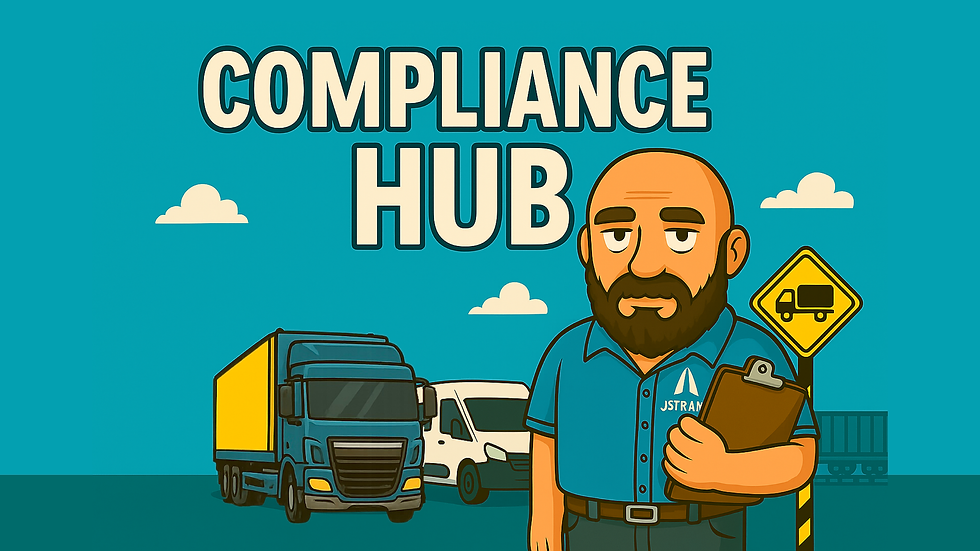Creating a Record-Keeping Policy for Your Transport Business
- stuart47304
- Jul 8
- 4 min read

Running a transport operation — even a small one under a Restricted Operator Licence — means you’re legally responsible for maintaining accurate, accessible records for your drivers, vehicles, and compliance activities.
But what happens when:
A DVSA examiner knocks on your door?
You’re preparing for a Public Inquiry?
You lose key staff or your admin system crashes?
That’s where a record-keeping policy becomes vital. It’s your proof that systems are in place to meet your undertakings — and that you’re in control of your business.
This guide will walk you through how to create a simple, professional, and DVSA-ready record-keeping policy for your transport operation.
What Is a Record-Keeping Policy?
A record-keeping policy is a written document that outlines:
What records you keep
Who is responsible for them
Where they are stored
How long they are retained
How you protect them from loss, damage or tampering
It’s not just paperwork — it’s evidence that you run a safe, compliant, and well-managed operation.
Why You Need One
✅ Helps you stay legally compliant
✅ Clarifies responsibilities within your business
✅ Speeds up DVSA inspections
✅ Reduces risk of missed deadlines or missing paperwork
✅ Demonstrates professionalism and good repute
✅ Supports you at a Public Inquiry if required
What Should Be Included in a Record-Keeping Policy?
Here’s a breakdown of what to cover and how to format your policy:
1. Purpose of the Policy
“This policy sets out how JS Transport Solutions collects, stores, manages and retains transport records in line with the undertakings of our Restricted Operator Licence and relevant DVSA guidance.”
2. Scope of Records
Outline the types of records you maintain. For example:
Preventative Maintenance Inspection (PMI) reports
Vehicle defect and repair records
Daily driver walkaround checks
Brake test reports
MOT certificates
Driver licence checks
Tachograph data (if in-scope)
GB domestic hours logs
Training and induction documents
Maintenance contracts and agreements
Operating centre permission letters
Insurance and financial standing documents
3. Record Storage Format
Explain whether records are paper, digital, or both.
“Records are stored in digital format on Google Drive, with paper backups retained for PMIs and daily defect checks. Each vehicle and driver has a separate file structure for easy access.”
4. Access and Retrieval
Document who has access and how quickly records can be retrieved.
“Transport records are accessible by the business owner and designated admin assistant. All records are filed by vehicle registration or driver name. DVSA-requested records can be retrieved within 10 minutes.”
5. Retention Periods
Include a quick-reference table.
Record Type | Retention Period |
PMI reports | 15 months |
Repair records | 15 months |
Walkaround checks | 15 months |
Driver licence checks | While employed + 6 years |
Tacho data | 12 months |
Domestic hours logs | 2 years |
MOT certificates | 15 months |
Training records | 6 years |
Financial standing evidence | Until replaced |
Operating centre agreements | While in use |
Insurance documents | 6 years |
6. Responsibilities
Assign responsibilities clearly.
Vehicle records: Managed by [Name]Driver records: Checked by [Name] every 6 monthsTachograph downloads: Monitored by [Name]Maintenance schedule: Reviewed monthly by [Name]Backups: Digital backup created weekly by [Name]
If you're a one-person operation, that’s fine — just list your name.
7. Backup and Security Measures
“Digital files are backed up weekly to an encrypted cloud account. Paper documents are stored in a locked filing cabinet within a secure office. All driver and vehicle data is handled in accordance with GDPR.”
8. Audit and Review
“This policy is reviewed every 6 months, or after any DVSA inspection or change to the business structure.”
Include a section to record when the last review was carried out.
Example Policy Statement
JS Transport Solutions: Record-Keeping Policy We maintain clear and accurate transport records to comply with our Operator Licence obligations. All records are stored securely and retained for the required period. The business owner, Stuart Hazeldine, is responsible for reviewing these records monthly and ensuring they are up to date and inspection-ready at all times.
Tips for Implementation
✅ Print and sign a copy — keep it in your compliance file
✅ Make sure every staff member involved knows the policy
✅ Set up email/calendar reminders for licence checks, inspections, and reviews
✅ Use folder templates and naming conventions for consistency
✅ Audit your current records — fill any gaps now
Common Mistakes to Avoid
Mistake | Why It’s a Problem |
❌ No written policy | Can’t prove control or planning at Public Inquiry |
❌ Inconsistent retention | Risk of missing records at DVSA inspection |
❌ Poor file naming | Wastes time during audits |
❌ No backups | Risk of loss due to fire, theft, or system failure |
❌ Not reviewing regularly | Records fall out of date quickly |
Conclusion
A simple, written record-keeping policy is one of the easiest ways to demonstrate to the DVSA and Traffic Commissioner that your transport operation is structured, compliant, and under control.
Whether you’re running one vehicle or ten, don’t wait for a knock on the door — put your system in writing, file it in your compliance folder, and make it part of your routine.
Next in the series:👉 What to Do if the DVSA Requests Documentation
